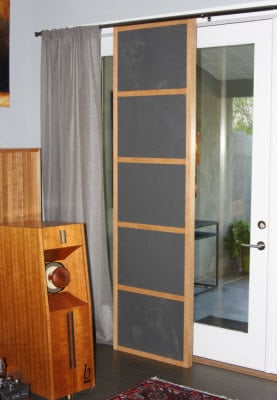This Blog has been updated from it original posting to reflect new information and changes in technology regarding acoustical curtains. Updated on 11/26/19
In last week’s Google Hangout I was asked about acoustical curtains. A guy wrote in to say “I’m looking to buy some to do the windows in my listening room. What should I be looking for thickness wise?
We’ve tried to develop a product for the windows in studios, home theaters and any application where music is concerned, because glass sound is just the worst sound that you can have in a room and if I had my way I would remove all windows from all music rooms! But unfortunately people like windows and they like to be able to use them and I get that. That said we’ve kind of put our research and development on hold for a window product because they’re just so expensive to develop.

Acoustic Fields Sliding Window Panel
Sliding Window Panel
We have now developed a sliding window panel for arcadia doors. It is our 2″ foam technology with a wood frame around it that slides across and retracts from a ball bearing rail system. Each individual panel is 27″ wide so you can have a series of 4 and close one side and open another or close all and cover the whole window. The foam is grey only. You can choose your wood for the frame. You can choose walnut, cherry, or maple. Panel heights can go to 8′ and higher if required. Custom sizes are available.
Sliding Window Panel: https://www.acousticfields.com/product/sound-absorbing-panels-for-windows/
Well if you’re looking for a permanent solution that’s more temporary in its application you can use foam technology and simply insert the foam in the window area while you’re using the room for your music. That will help considerably. If you’re going to go to a drapery system then you need to have a drape that’s thick enough to absorb the energy in the room and also the reflections off the glass.
Your Acoustic Curtains Have to do Two Things.
Acoustical curtains or acoustic drapes have to absorb the reflections off the glass and then they have to absorb the energy within the room. It has a double purpose. You have to be very careful when you buy drapes in, that one side of it is not reflective and one side of it is absorptive.
Sometimes these linings that drapes have are pretty dense so you won’t get much absorption off the window reflection because not all the energy is going to be absorbed. Thicker is the rule of thumb, thicker is better. A looser weave fabric. Look for a fabric that has a density to it that you know will work for sound absorption. look for drapes that have numerous layers of materials. The layers of different material thicknesses will increase the rate and level of absorption.
It’s a difficult call any fabric will be better than no fabric. Choosing the right kind of fabric is difficult because there are no published specifications on rates and levels of absorption of fabrics. It’s kind of a guessing game but airing on the side of caution any fabric over a window is better than none.
The company that we use is Guilford Of Maine. We have tested their fabrics and they allow enough airflow for our foam to work. Over 50 colors and textures are available.
Fabric Link: https://www.guilfordofmaine.com/acoustic
In Summary
I hope this information helps to solve the problem you are having. Please message me at info@acousticfields.com if you have any questions as I am always happy to help. If you want more to learn more about room acoustics please sign up for our free acoustic video training series and ebook. Upon sign up you will instantly have access to a series of videos and training to help improve the sound in your studio, listening room or home theatre.
Thanks,
Dennis







